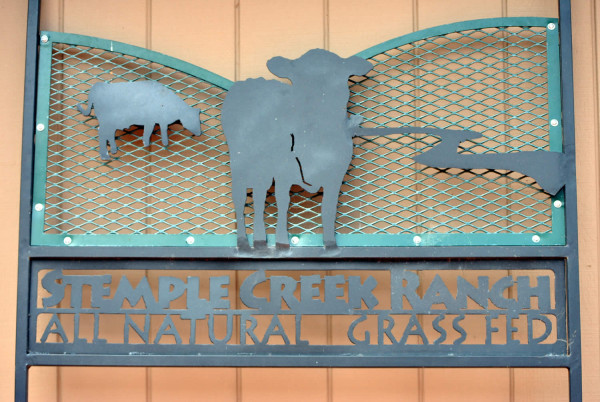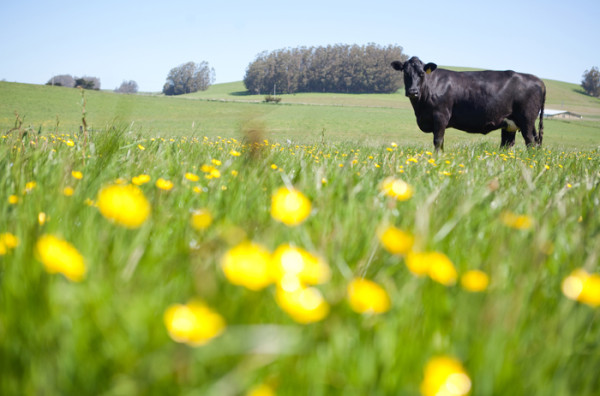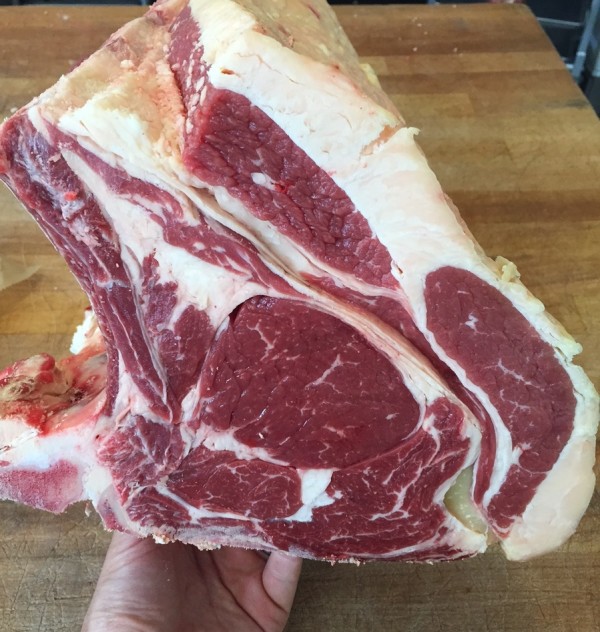Concerned about climate change? We are, too! Pastured animals are an essential part of regenerating our soil. Soil regeneration combats climate change. This new year we resolve to educate our friends and customers about the virtues of pasture-raised animal husbandry.
—Monica & Aaron Rocchino & The Local Butcher Shop Team
Like a lot of ranchers, Loren Poncia has a favorite early morning spot where he likes to sit in his truck, drink coffee, and look out over his land. He’ll lift his binoculars to make sure that various gates are set correctly, that his cows are in the right pastures, and that nothing on his thousand acres demands his immediate, pre-caffeinated attention. But what sets this fourth-generation rancher apart from some of his peers is how proud he is of the simplest thing on his property. Specifically: dirt.
“Forget the cows,” he tells a visitor on a frigid November morning. “I’m a photosynthesis farmer.” Even though spurs and Stetsons and the open range maintain a firm hold on the American imagination, the actual business of modern ranching is a completely different animal. Good cows are made from good grass, and good grass comes from good dirt. And what makes good dirt? Carbon. Release carbon into the atmosphere and you’ve got yourself a global warming problem. But trap that same carbon in the ground and not only do you reduce the risk of climate change, but you create the ideal conditions for sustainable, year-after-year-after-year grass growth, which means free-roaming cows who never see a feedlot or taste anything that isn’t pure, clean, organic grass. Poncia’s Stemple Creek Ranch never sells to big corporate packagers, instead sending everything direct to consumers through stores like The Local Butcher Shop, which gets 50% percent of its meat from this Marin County producer.
“You can make grass grow in three ways,” Poncia continues. “Plows, worms, or roots. And we don’t use plows.” Plowing might churn up the soil enough for short-lived, annual grasses to take hold but it also releases all that stored carbon back into the atmosphere. So Poncia takes a longer view, one that benefits both his herd and the environment. “Take a look at that field over there. It hasn’t been rained on in seven months and it’s still green, even though it’s been grazed twice in the dry season. That doesn’t happen by accident.” Without plows, Ponica works hard to keep the fields healthy so that taproots will grow long, reaching deep underground for water, aerating the soil and keeping it healthy for next year’s grass.

Poncia and his crew practice a labor-intensive method of ranching, where the acreage is fenced into dozens of separate pastures. Cows rotate through the fields, staying in each place for only a brief period. In that way, grass gets a chance to fully regenerate before it’s grazed again. This encourages the growth of native perennial grasses, rather than short-lived annual grasses that grow once and then die, exhausting soil nutrients in the process. Under Poncia’s management, the all-important dirt stays spongy and rich, never compacted and chalky. “We’ve increased the biomass in the soil from one percent to five percent,” he says. “It used to be that after eight inches of rain, water would run off the soil, but now we hold onto twelve inches. That’s what healthy roots do, they keep that water on the land instead of letting it run off and cause erosion.”
Poncia’s parents and grandparents may not have have ranched the same way he does now, but Poncia is following a management plan that is even older. “This land was always grazed,” he says, referring to the massive herds of tule elk and other ungulates that roamed California before human settlement. Those herds would graze intensely and then move on, never overwhelming any one place. Problems arose when ranchers stocked more animals than a landscape could bear, compacting the soil and depleting it of nutrients. That overgrazing created a destructive spiral that eventually required the wide-spread use of plows, fertilizers, antibiotics, and feedlots to get cattle to produce the same amount of meat they once had on pasture alone. Poncia’s system of constant rotation and attention to soil health mimics ancient grazing patterns, and the results have been phenomenal.

Not only is Stemple Creek producing twice as much meat on the same acreage as it did decades ago, but the environmental footprint has actually decreased. “We’re sequestering a thousand pounds of carbon per acre,” taking harmful chemicals out of the atmosphere and locking them into the soil, where they can turn sunlight into grass and grass into meat. The ranch is certified organic—no chemical fertilizers, antibiotics, or weed-killers—and Poncia does everything he can to improve the land. Since he took over management of the farm he’s planted ten thousand trees and fenced off all the riparian areas. Stemple Creek now has a vastly reduced amount of soil erosion, water quality that is on the rise, and over fifty species of migratory birds that can be found on the property. “When I was a kid those creeks would turn green and all the fish would die,” Poncia says. “Now they’re clear and clean and the fishing is great. Who knows, we might even see salmon and steelhead back in there one day.”
Improved environmental quality, higher production, and a better-than-neutral carbon footprint are great. But Poncia doesn’t overlook the real bottom line: Stemple Creek meat simply tastes better than anything you’ll find in a grocery store. “It has a real terroir, like wine,” he says. “Some of my cows like clover better. Some like the rye grasses.” Unlike feedlot beef, which is fatty and homogenous, Poncia’s organic, grass-fed beef has a distinctive flavor that reflects the clean earth it comes from.

So when Poncia looks out over his ranch, nestled between Mt Saint Helena and the deep fjord of Tomales Bay, he’s thinking about a lot more than just cows. “It’s the whole package,” he says: dirt and grass and healthy streams and good-paying local jobs and land that’s been placed into a trust so it can never be subdivided or exploited. He lowers his binoculars and drops his truck into gear, ready for another day of whatever mother nature has in store for him and his cattle. “This is the hard way to do things,” he muses. “But it’s worth it.”

I gotta admit it. It sure looks good.